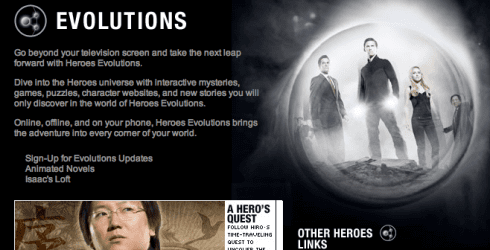Above: one of « Heroes »‘ beyond-TV incarnations; below: Nick DeMartino
Part 1 of this three-part series suggested that money, creativity, demand and buzz have conspired to bring Transmedia into the mainstream, despite or perhaps because of a testy flame-war within those producing cross-media stories.
Leading transmedia talent has emerged from a wide array of disciplines, including technology, indie film, fantasy games, marketing, comic books, videogames, advertising, brand advertising, television production, theme parks, academia, and, of course, the internet.
What sets each apart is a willingness to embrace meaningful audience participation in the transmedia projects that capture their passion.
“I think that the idea of participation is one of the key things we are all wrestling with, both fans and authors, movie directors or whatever kind of creative person we’re talking about, » says author Frank Rose. “Participation raises the question of whose story is it? And, the answer I think is, it’s all of ours. In order to really identify with the story, in some way we have to make it our own.”
Here’s some of what I’ve learned in conversations with a range of transmedia leaders.
Bonds: The Audience is Ready

“We are tapping into a real demand from consumers,” says Susan Bonds, CEO of 42 Entertainment, a company that produces alternative reality games (ARGs) like “Why So Serious?” for The Dark Knight, and Nine Inch Nails’ “Year Zero.”
“This is something that people want, and so studios are beginning to open up their creative properties to allow people to participate.”
Not only has the company has been pivotal in defining the ARG form, it has been home for key talent. Bonds, who is an industrial engineer with gigs at Disney, Lockheed, and Cyan, says that the art form follows the trajectory of the audience:
“In the first half of the decade, it was all about early adopters, the in-crowd playing interactive games, the first to buy the latest technologies. But now, the novelty factor has worn off, and it’s about the experience. People are already emotionally invested and aware that all of these things are at their fingertips. Now they know.”
Early adopters still play a central role in most ARG projects. Check out “Test Subjects Needed”, a scenario that is currently dribbling out on the web and at E3 and Bonnaroo, for which 42 Entertainment is alleged to be the agency. And the client? Wrigley’s Gum.
42 Entertainment plans to apply lessons from its client work to create new and original transmedia content. Bonds would not discuss details with me, telling me to keep my eyes open “later this year.”
“We’re ready to evolve the business model,” says Bonds. “We’ve seen that people in the millions and tens of millions will come together for a collective experience. Think of the freedom that this gives you! You can do the work on a smaller scale than a $100 million movie, and you are no longer necessarily held to the traditional ways of starting the work, either business or creative.”
Gomez: Appealing to deep aspirations and fantasies

Jeff Gomez’s “aha moment” came at a young age.
“When I was 12 we moved to Hawaii, where I was exposed to what in Japan they call Mangaka, or storyteller. Mangaka has told his story over many volumes of comic books — Japanese Manga — and was granted the responsibility to tell that story in the animated television series, in the toy line, in the feature film, in the prequels and sequels. That was my dream job.”
With Starlight Runner, the company Gomez co-founded in 2000, he’s halfway to his dream. The company extends entertainment properties across time and media for clients with movies (“Pirates of the Caribbean,” “Avatar,” and “TRON”); games (Halo); and products (Coke’s Happiness Factory, Hasbro’s Transformers).
Fantasy role-playing games were Gomez’s first love, leading him to launch a fanzine called “Gateways” , which in turn led to gigs in comic books and videogames.
In the fantasy role-playing scene, “a story was unfolding that could not be told without the participation of my fellow game players, the people who were playing roles in the world of the story I was creating,” Gomez says. “The participation is what triggered deep emotional responses. Storytelling, particularly your character in my story, allowed me to create scenarios that appealed to your deepest sense of aspiration, your fantasies, your desires.”
Like everyone in the secretive transmedia field, Gomez would not reveal his own plans for his proprietary transmedia projects, though it is clear that original production is his dream. In the meantime, Gomez spends a chunk of each month giving workshops and mentoring aspiring transmedia artists around the world, including a workshop in Sydney with X-Media Lab.
Weiler: Storytelling without Boundaries
 Computer editing was the technology that triggered Lance Weiler’s personal digital epiphany, leading to the production of “The Last Broadcast,” an early digital film. Its website featured ARG-style elements such as 911 calls and fake newspaper items intended to deepen the paranormal mystery story being told in the film. “It was a forerunner to the idea of building and crafting a world around the main story,” Weiler told me.
Computer editing was the technology that triggered Lance Weiler’s personal digital epiphany, leading to the production of “The Last Broadcast,” an early digital film. Its website featured ARG-style elements such as 911 calls and fake newspaper items intended to deepen the paranormal mystery story being told in the film. “It was a forerunner to the idea of building and crafting a world around the main story,” Weiler told me.
He describes his approach as “storytelling without boundaries,” an approach on display in his projects like 2006’s “Head Trauma” and 2011’s “Pandemic”.
He evangelizes this bottom-up, do-it-yourself approach, as in this recent speech at Ireland’s Darklight Festival.
“I think what you see is a major shift from as top-down, permission-based culture to one in which people are experimenting more.” Weiler says that “the audience is actually ahead of the industry, just waiting for storytellers to catch up. Maybe the big story is that the illusion of being an auteur is moving into balance, becoming more of a conversation when it used to be that you were talking at the audience.”
In addition to his own projects, Weiler runs a network called Workbook Project and a roving conference called DIY Days He consults with organizations like the World Economic Forum, and collaborates with other producers on participation techniques.
Alexander: Breakthroughs start at the Top
 For TV writer-producer Jesse Alexander transmedia breakthroughs can only happen with “a visionary leader at the highest level.” He should know, as a producer and writer on both ABC’s “Lost” and NBC’s “Heroes,” two iconic series that set the bar for content extensions on the web.
For TV writer-producer Jesse Alexander transmedia breakthroughs can only happen with “a visionary leader at the highest level.” He should know, as a producer and writer on both ABC’s “Lost” and NBC’s “Heroes,” two iconic series that set the bar for content extensions on the web.
“They were special shows,” says Alexander. “We had great timing and money to extend those stories. We’re in a different world now.”
A big factor was the 2007-08 Hollywood writers’ strike, which Alexander called “catastrophic,” followed shortly by the global recession. His own series, “Day One,” was killed in 2010, a casualty of the Comcast-NBC Universal buy-up.
“There is no infrastructure to do transmedia, so you have to borrow from lots of buckets to find the resources,” says Alexander, especially for new shows without a proven audience. “So there are a lot of exciting and ephemeral transmedia experiences that market films, TV and games … but what is the sustainable model beyond six weeks?”
Alexander told me that independent filmmakers and game developers might have an easier path to transmedia than mainstream Hollywood. “You’re not going to see innovation from the large media companies. There’s just no real incentive for them to change it all up.” They have what Alexander calls a “fire-and-forget” model. “It drives you crazy — so much time and money on a transmedia project, and it’s over in six weeks.”
He is excited about the prospects of independent transmedia studio Fourth Wall, founded by pioneer Elan Lee, who has gathered some of the art form’s leading practitioners and raised a large capital infusion to produce original content.
Clark: The Innovation is Other People
 “The real innovation of the Internet is other people, not just data,” GMD Studio’s Brian Clark told me, which is what inspired him to co-found IndieWire.com in 1996 and to produce films like “Nothing So Strange “, which imagined the assassination of Bill Gates. Since then, he has been busy crossbreeding indie filmmaking, the web, brand marketing and creative services. He likes to think of the web as a production tool, and the outcome as alternate reality games (ARGs).
“The real innovation of the Internet is other people, not just data,” GMD Studio’s Brian Clark told me, which is what inspired him to co-found IndieWire.com in 1996 and to produce films like “Nothing So Strange “, which imagined the assassination of Bill Gates. Since then, he has been busy crossbreeding indie filmmaking, the web, brand marketing and creative services. He likes to think of the web as a production tool, and the outcome as alternate reality games (ARGs).
“With ARGs,” says Clark, “you’re writing a work that doesn’t really exist until it’s populated by the audience. The audience’s interaction with it is what creates the moment. You’re hanging cameras around and putting microphones on things and to capture a moment that you’ve created. That is a production technique, and it’s what the web is really good at.”
Clark calls himself an “experience designer,” placing the focus upon audience participation. GMD typically works with a team of collaborators, both individuals and companies like Mike Monello’s Campfire. Monello’s work ranges from “Blair Witch Project” through this season’s HBO hit “Game of Thrones.”
GMD’s techniques caught the attention of ad agencies and brands, and “they seem to want to buy,” says Clark, whose work include projects for Sega, Scholastic and Audi. 2005’s “Art of the Heist” employed a wide range of digital and real-world elements that involved half a million consumers in a faux theft of Audi’s then-new A3 car.
Not surprisingly, Clark, who is working on a major 9/11 project, believes that the art form is ready to soar. “Never have I seen more money available for this kind of work. For all the failures we’re talking about with Hollywood and advertising, the taste is there now.”
It’s a Global Phenomenon
My original research focused primarily upon North American transmedia producers, probably because in part I started with the PGA brouhaha. But it’s clear that transmedia practices and experiences can be anywhere in the world where visual storytelling flourishes, especially in Europe and Australia-New Zealand.
One of the earliest conversations I had was sparked by “Collapsus”, a project that combines interactivity, animation, fiction, and documentary to tell a story about the global energy crisis. The project, which took top honors at the SXSW interactive conference, is the work of Amsterdam-based producer Submarine and director Tommy Pallotta, the U.S.-born director of “Waking Life” and “A Scanner Darkly.”
Femke Wolting of Submarine ran an interactive exhibition programme at the Rotterdam Film Festival for years. “Europeans are ahead of the US when it comes to original cross-platform work, largely because of government-subsidises and co-productions,” she says, noting that European broadcasters and film authorities have been allocating production funds for “new media” components for longer than their U.S. counterparts.
Pallotta and Wolting are working on an interactive web documentary about propaganda called “Unspeak” and a feature, “Eisenstein in Guanajuato” with British director PeterGreenaway, both of which include multi-platform elements.
When Dutch producer Dominic de Haas read this series in early July, he was shocked that I didn’t include a pioneering European transmedia project from Nokia and its agency, Bikker Euro RSCG, way back in 1999.
Nokia’s earlier efforts provide context for a major current project, the international high-budget multiplatform story called “Conspiracy for Good” which launched in 2010. Headed by “Heroes” creator Tim Kring, the project counts Nokia as a sponsor and hundreds of collaborators, including Stockholm-based The Company P, which had set a standard for ARG’s with “The Truth about Marika” in 2007.

CFG’s first on-the-ground component played out in London. Expect to see more iterations of “CFG” in coming months, along with a new Kring multiplatform project for a major TV network, predictably Top Secret at this point.
Two emerging transmedia artists, Spaniard Ricard Gras and Canadian Josh Shore also provide a glimpse of new thinking from younger digital natives.
Ricard Gras, whose UK-based firm Inter-activa designs virtual-worlds, is in post-production on “Vlogger: The Movie”, a story set online and in Second Life. The project will roll out this fall as a movie, a social media experience and as an environment inside Second Life, where users will have access to additional story-related material, somewhat akin to DVD extras, Gras says.
VLOGGER employs cinematic language derived from Machinima movies that use “gravity-free cameras” and employs an inventive interface to simultaneously display the worlds of the “real” characters and the “virtual” characters. It will be interesting to see how this plays in a theatre.
“It wasn’t like we were reading a textbook and figuring out that transmedia was this new thing that we wanted to be part of,” says producer Josh Shore, who with Anson Phong has launched a multi-year, multiplatform project with an intentional social network called Dreamcatcher.
The site is designed to serve a “psychographic” community interested in the thematic universe of dreams and dream-sharing, which is at the heart of a linear narrative that will be told in a motion comic and animated film called “Illuminated,” now in development. “We’re looking at how we can build a community around a world view.”
Says Shore: “If you’re open to a participatory community in the digital age, there are a million opportunities.
Next: Part Three: Tracking the Wild Beast
Nick DeMartino retired as SVP, Media & Technology at the American Film Institute in 2010 to consult with companies on their content and distribution strategies, deals and marketing initiatives. You can find him on:
- Twitter: @nickdemartino
- www.nickdemartino.net
- His Delicious account
- & on Slideshare, here.
A different version of this series of posts is published by Tribeca’s Future of Film site here.





